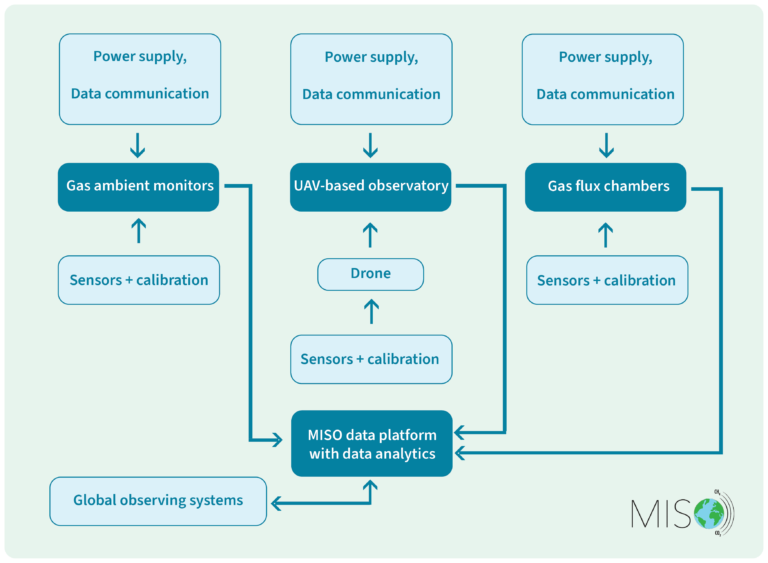This is the
MISO project
MISO develops an autonomous observation system for monitoring of emissions of CO2 and Methane, the two most important greenhouse gases. The system is modular and is suited for use in hard-to-reach areas such as the Arctic or wetlands. It combines three observing platforms (a static tower-Gas ambient monitor , a static gas flux chamber and a UAV-based observatory using NDIR sensing technologies ) with a cloud platform. The system can be operated remotely , with minimum on-site intervention.
The MISO team has expanded existing technologies: we have improved detection limit and accuracy of an NDIR GHG sensor integrated in the platforms. The static platforms and the drone base are powered by a unique geothermal device. The communication between the three observing platforms and a data cloud uses a combination of Peer2Peer, G4/G5/LTE, LORAWAN and wifi technologies.
To ensure consistent measurements, the observing platforms are optimized for energy efficient autonomous operation. This includes on-platform detection of faults through an optimized Machine Learning calibration. The cloud platform stores model updates and fault detection information together with the raw measurements.
The system is co-developed with stakeholders from academia, monitoring and measurement systems, industry and policy. It is thoroughly documented and has been demonstrated in the Arctic and in Wetland .

NEWS

❄️🔋 𝐌𝐈𝐒𝐎 𝐒𝐯𝐚𝐥𝐛𝐚𝐫𝐝 – 𝐄𝐧𝐞𝐫𝐠𝐲-𝐄𝐟𝐟𝐢𝐜𝐢𝐞𝐧𝐭 𝐆𝐚𝐬 𝐀𝐦𝐛𝐢𝐞𝐧𝐭 𝐌𝐨𝐧𝐢𝐭𝐨𝐫
During the Svalbard field campaign, the MISO team tested an energy-efficient gas ambient monitor designed for long-term operation in harsh Arctic conditions. 🧠 𝐓𝐢𝐧𝐲𝐌𝐋 𝐎𝐧-𝐝𝐞𝐯𝐢𝐜𝐞 𝐂𝐚𝐥𝐢𝐛𝐫𝐚𝐭𝐢𝐨𝐧Using TinyML, the device runs a calibration model directly on the sensor node. Together with the K96 gas sensor, this enables accurate, real-time greenhouse gas

❄️🚁 𝐌𝐈𝐒𝐎 𝐒𝐯𝐚𝐥𝐛𝐚𝐫𝐝 – 𝐄𝐧𝐝-𝐭𝐨-𝐄𝐧𝐝 𝐃𝐚𝐭𝐚 𝐓𝐫𝐚𝐧𝐬𝐦𝐢𝐬𝐬𝐢𝐨𝐧 𝐓𝐞𝐬𝐭
During the Svalbard field campaign, the MISO team carried out additional communication tests to support autonomous GHG monitoring in Arctic conditions. ✅ 𝐀𝐜𝐡𝐢𝐞𝐯𝐞𝐦𝐞𝐧𝐭𝐬 ⚠️ 𝐋𝐞𝐬𝐬𝐨𝐧𝐬 𝐋𝐞𝐚𝐫𝐧𝐞𝐝 Thanks to Huy Duong Gia, Torbjørn, Vishall, Jurian, and Thibault for their work during these tests. 📸 More insights from the Svalbard campaign coming

🌐❄️ 𝐌𝐈𝐒𝐎 𝐒𝐯𝐚𝐥𝐛𝐚𝐫𝐝 – 𝐄𝐧𝐯𝐢𝐫𝐨𝐧𝐦𝐞𝐧𝐭𝐚𝐥 𝐈𝐧𝐭𝐞𝐥𝐥𝐢𝐠𝐞𝐧𝐜𝐞 𝐓𝐞𝐬𝐭
As part of the Svalbard field campaign, we tested and validated our live update framework and communication setup for autonomous, intelligent sensors operating in Arctic conditions. 🧠 𝐋𝐢𝐯𝐞 𝐍𝐞𝐮𝐫𝐚𝐥 𝐍𝐞𝐭𝐰𝐨𝐫𝐤 𝐔𝐩𝐝𝐚𝐭𝐞A key goal was to verify that our low-power STM32-based sensor device could receive, authenticate, and install updated neural-network weights

🌍❄𝐀𝐫𝐜𝐭𝐢𝐜 𝐏𝐢𝐥𝐨𝐭 – 𝐌𝐢𝐬𝐬𝐢𝐨𝐧 𝐂𝐨𝐦𝐩𝐥𝐞𝐭𝐞𝐝!
The MISO team wrapped up its 𝐟𝐢𝐧𝐚𝐥 𝐟𝐢𝐞𝐥𝐝 𝐜𝐚𝐦𝐩𝐚𝐢𝐠𝐧 𝐢𝐧 𝐋𝐨𝐧𝐠𝐲𝐞𝐚𝐫𝐛𝐲𝐞𝐧, 𝐒𝐯𝐚𝐥𝐛𝐚𝐫𝐝, pushing our monitoring technologies to the limit under 𝐞𝐱𝐭𝐫𝐞𝐦𝐞 𝐀𝐫𝐜𝐭𝐢𝐜 𝐜𝐨𝐧𝐝𝐢𝐭𝐢𝐨𝐧𝐬. 🚁 𝐀𝐮𝐭𝐨𝐦𝐚𝐭𝐢𝐜 𝐝𝐫𝐨𝐧𝐞 𝐛𝐚𝐬𝐞 – successfully performed autonomous GHG measurements.🔹 𝐆𝐚𝐬 𝐚𝐦𝐛𝐢𝐞𝐧𝐭 𝐦𝐨𝐧𝐢𝐭𝐨𝐫𝐬 & 𝐟𝐥𝐮𝐱 𝐜𝐡𝐚𝐦𝐛𝐞𝐫 – tested and validated in the field.🔹 𝐄𝐧𝐝-𝐭𝐨-𝐞𝐧𝐝 𝐝𝐚𝐭𝐚 𝐭𝐫𝐚𝐧𝐬𝐦𝐢𝐬𝐬𝐢𝐨𝐧– proven
Contact Info
Dr. Tuan-Vu Cao, project coordinator.
The Climate and Environmental Research Institute NILU.

This project has received funding from the European Union’s Horizon Europe research and innovation programme under Grant Agreement No. 101086541.








